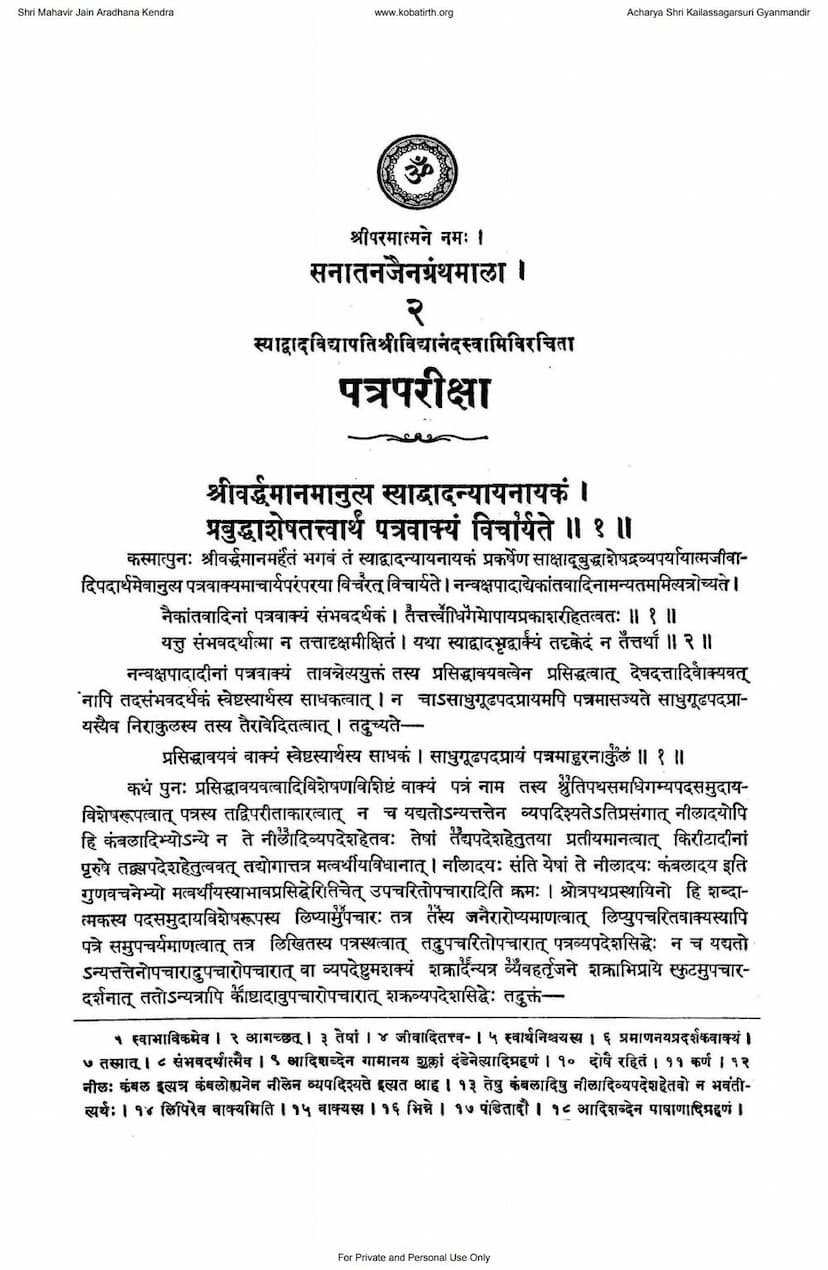Patra Pariksha
Added to library: September 2, 2025

Summary
Here's a comprehensive summary of the provided text, "Patra Pariksha" by Vidyanand Swami, based on the given pages:
The text "Patra Pariksha" (Examination of a Letter/Statement) by Vidyanand Swami, published by Sanatan Jain Granthmala, is a deep dive into the nature of valid communication and argumentation, particularly from a Jain perspective, contrasting it with other philosophical schools.
1. Defining "Patra" (Letter/Statement):
The text begins by defining what constitutes a "patra" (a letter or a statement in the context of debate or logical discourse). A "patra" is characterized as:
- Containing meaningful words (संभवदर्थक): It must have a purpose and convey comprehensible meaning.
- Being comprehensible and well-formed (प्रसिद्धावयवं): The sentence structure and words should be clear and properly formed.
- Serving its intended purpose (स्वेष्टस्यार्थस्य साधक): The statement must be capable of proving or supporting the speaker's intended argument.
- Using appropriate and clear language (साधुगूढपदप्रायं): It should employ correct and appropriately understood words, not necessarily overly simple but also not obscure without reason.
- Being devoid of confusion or anxiety-producing elements (अनाकुलं): The statement should aim for clarity and avoid causing distress or unnecessary doubt.
The text argues that statements made by those with exclusive viewpoints (एकांतवादिन्), like Akshapada (Gautama, the proponent of Nyaya), are not true "patra" because they lack these qualities. Specifically, their statements are criticized for:
- Lacking proper structure (प्रसिद्धावयवत्वस्य विरहात्): Their arguments often lack the necessary logical components as defined by Jain philosophy.
- Not always conveying achievable meanings (असंभवदर्थकं): Their conclusions are sometimes based on flawed or unattainable premises.
2. Critique of Non-Jain Logical Systems:
A significant portion of the text is dedicated to refuting the logical frameworks of other schools of thought, particularly those who adhere to exclusive viewpoints (ekantavada).
- Critique of Nyaya (Akshapada): The text deconstructs the five-membered syllogism (panchavayava) proposed by Nyaya (Pratijna, Hetu, Udaharana, Upanaya, Nigamana), arguing that these are not necessarily present or sufficient for true knowledge. It points out that even flawed arguments (patrabhasa) can sometimes exhibit these five limbs, and true understanding comes from the valid relationship between the reason (hetu) and the subject of proof (sadhyavinabhavaniyama). The text highlights that the Nyaya structure often fails to establish the essential relationship or validity required for certainty.
- Critique of Buddhism (Sugata): The text criticizes the Buddhist emphasis on momentary existence and the denial of permanent substance, finding their logical structures equally flawed and lacking the depth required for genuine understanding.
- Critique of Sankhya and Yoga: These schools are also implicitly criticized for their exclusive views on the nature of reality and knowledge.
3. The Jain Syādvāda (Anekāntavāda) as the True Path:
The text strongly advocates for the Jain philosophy of Syādvāda (anekāntavāda – the doctrine of manifold aspects) as the true method for understanding reality and constructing valid arguments.
- Syādvāda as the foundation of "Patra": Jain arguments, rooted in Syādvāda, are presented as inherently "sambhavadarthaka" (meaningful and possible) because they acknowledge multiple perspectives and the complex nature of reality.
- Importance of the "Hetu" (Reason) and its Relationship to the "Sādhya" (Thing to be Proven): The core of valid reasoning, according to the text, lies in the inseparable connection between the reason and what is to be proven (sādyāvinābhāva). This relationship is what makes an argument valid, not just the presence of rhetorical devices or syllogistic structures.
- The Necessity of "Sādhana" (Means) with "Sādhya" (Goal): The text emphasizes that simply presenting a reason (hetu) without its accompanying subject of proof (sādhya) is insufficient. The statement must clearly indicate both what is being asserted and the reason for it.
- Flexibility in Argument Structure: The text acknowledges that the number of limbs in a statement can vary based on the need to explain to the recipient (pratipadyanurodhena). While a complete structure is ideal, even a single valid reason (hetu) when understood in context can be sufficient.
4. Key Concepts Discussed:
- Dravya and Paryaya (Substance and Mode): The text delves into the Jain understanding of substance (dravya) and its modes (paryaya), arguing that they are neither entirely identical nor entirely different. This concept is crucial for understanding how reality can have multiple aspects.
- The Nature of "Sattva" (Existence): The text discusses the nature of existence, linking it to the concept of origination, decay, and permanence (utpāda-vyaya-dhrauvya). It criticizes views that hold exclusively to one of these aspects, highlighting the Jain perspective of their simultaneous presence.
- The Relationship between Cause and Effect: The text examines the relationship between cause and effect, emphasizing the interconnectedness and interdependence of phenomena.
- The Role of Proof and Knowledge: The text stresses that true knowledge and valid arguments stem from reliable means of proof (pramana) and are not based on mere assumption or exclusive viewpoints.
5. Conclusion:
The "Patra Pariksha" concludes by reasserting the superiority of the Jain approach, particularly Syādvāda, in understanding reality and constructing valid arguments. It criticizes other schools for their one-sided or exclusive viewpoints that lead to incomplete or erroneous conclusions. The text argues that only the Jain perspective, with its acknowledgment of multiple aspects and its emphasis on the inseparability of reason and proof, can truly be called a "patra" and lead to genuine knowledge and victory in intellectual discourse. The work is presented as a guide for those seeking to understand the true nature of reasoned discourse.